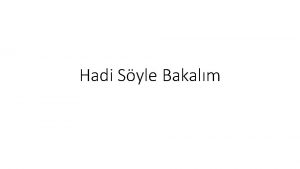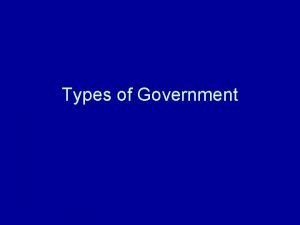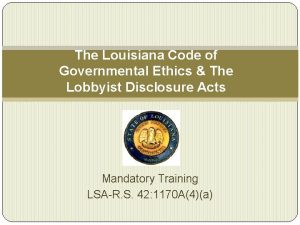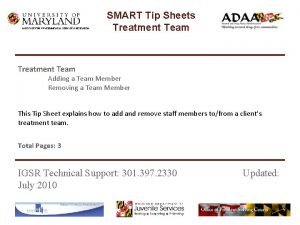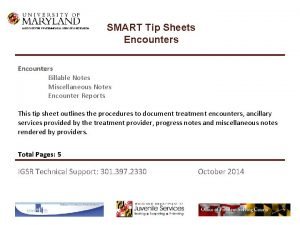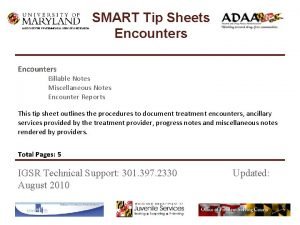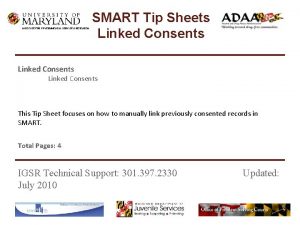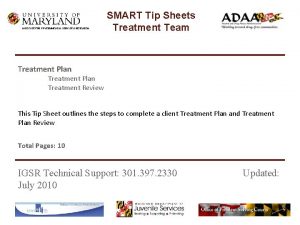INSTITUTE FOR GOVERNMENTAL SERVICE RESEARCH SMART Tip Sheets






- Slides: 6

INSTITUTE FOR GOVERNMENTAL SERVICE & RESEARCH SMART Tip Sheets Basic Navigation SMART Basic Navigation Menus/Toolbars Navigation Buttons/Table Actions Controls Conventions This tip sheet focuses on the elements required for navigation and data entry. Total Pages: 6 IGSR Technical Support: 301. 397. 2330 July 2010 Updated:

SMART Basic Navigation Menus/Toolbars 1. Menus: The SMART Main Menu appears in the far left column of the screen. First level menu items are leftmost aligned and may include: Home, Agency, Client, My Settings, Reports, among others (depending on the user’s level of access). Sub-Menus: Once the user has selected a First Level function, using the First Level Menu selection (e. g. My Settings), the menu expands to display the Second Level Sub-Menus. The Sub-Menus allow the user to navigate to specific screens without having to use next and back keys. Sub-Menus can be identified by a small triangle to the right of the label (pointing to the right). The triangle points down when the Sub-Menu is displayed. To choose a menu item, put your mouse over the item and single click the item. 2. Toolbar Icons: The Browser Label depicts the name of the browser vendor (e. g. Microsoft Internet Explorer). User Identity & Context identify the User (person logged into SMART), the Location (agency/facility the user is logged into) and the client’s record opened to be worked on. 2 The Print View icon, allows the user to print a formatted record of the module being worked on and is available on all screens. The Print Report icon, allows the user to print a formatted record of the module being worked on. Logout allows the user to logout of the application. First Level Menu Second Level Sub Menu User Identity & Context Print View icon Print Report icon Logout

SMART Basic Navigation Buttons/Table Actions 1. Navigation Buttons: The Go button is used to initiate a query (e. g. Clicking Go from the Client Search screen will generate a list of clients at the agency). a. 2. 3 Cancel, Save, Finish and Next allow the user to move through a particular SMART module (e. g. Admission), where Cancel cancels your transaction and no work is saved; Save saves your work, but you remain on the same screen; Finish saves your work and returns you to the original screen; Previous takes you to the previous screen; and Next advances you to the next screen in the module. Table Actions & Hyperlinks: Table actions allows the user to create, edit or delete information. a. A yellow underlined hyperlink, allows the user to create (add) a new record. For example, clicking Add Client will allow the user to add a new client record. b. Blue underlined hyperlinks, allows the user to take actions. For example, Review allows the user to review an existing record. Delete allows the user to delete a record.

SMART Basic Navigation Controls 1. 4 Textbox: Text boxes are designed to allow the user to enter data in manually. Some text fields have specific formats which must be used for example: a. DOB/Date: mm/dd/yyyy b. SSN: nnn-nn-nnnn c. Phone Number: nnn-nnnn 2. Scrolling Textbox: Scrolling textboxes are used to capture notes and descriptions. A scrolling textbox allows the user to enter at least 500 characters. Some have no character limits. An example of a scrolling textbox is a Comment field. 3. Drop-down box: A drop-down box is used where only one entry may be selected from a list of values. 4. Mover Box: A mover box is used where more than one entry may be selected from a list of values. Some may scroll. Must display at least 4 rows of text. 5. Mover Box with Radio Buttons: The user selects an option with a single left click. Before selecting the mover arrow, the user must select an option, using the radio buttons located between the boxes. In this example, if the user selects # of Days, the user clicks the Radio Button, and put the number of days in the textbox using the keyboard. The user then moves the options to the select box using the upper arrow adjacent to the Selected Options box.

SMART Basic Navigation Conventions 1. Required Fields: required fields will be indicated by a yellow background. Dark yellow fields are system required fields and the record cannot be saved if a dark yellow field is incomplete. 2. Reporting: if a field is not required data for integrity, but is required to support reporting requirements for the state or agency, the background is pale yellow. Note: If any record with a pale yellow field is incomplete, then the entire ADAA admission or discharge record will be incomplete. Incomplete records will not be submitted to ADAA through the monthly reconciliation process. Note: Exception to the Rule - when documenting the ASI, all fields must be complete, whether they are white or yellow. 3. 5 Incomplete Required Fields: incomplete required fields will generate a warning error, and will be indicated by a peach background when the user tries to save the record.

SMART Basic Navigation Shortcuts 6 1. Tab Key (Keyboard): moves the user from field to field. 2. Control Key (Keyboard): Holding down the control key while selecting multiple options in mover boxes allows the user to select and move more than one selection in a mover box. 3. Shift Key (Keyboard): Holding down the shift key while selecting options in a mover box will allow the user to choose multiple sequential options. 4. Helpful Hints: Moving your mouse over a field will generate a helpful hint box providing additional information about the data field. 5. Sort: a user can sort list items, such as those in the Activity List or Episode List by clicking on the category title. For example in the Activity List, if the user clicks on Date, the list will automatically sort the list of activities by date.
